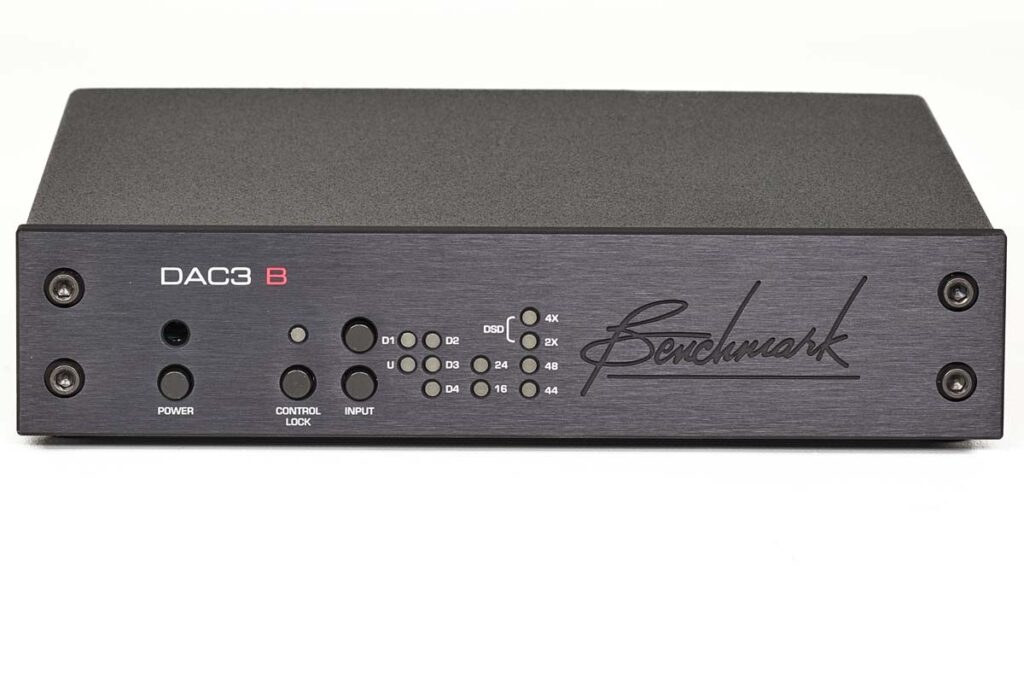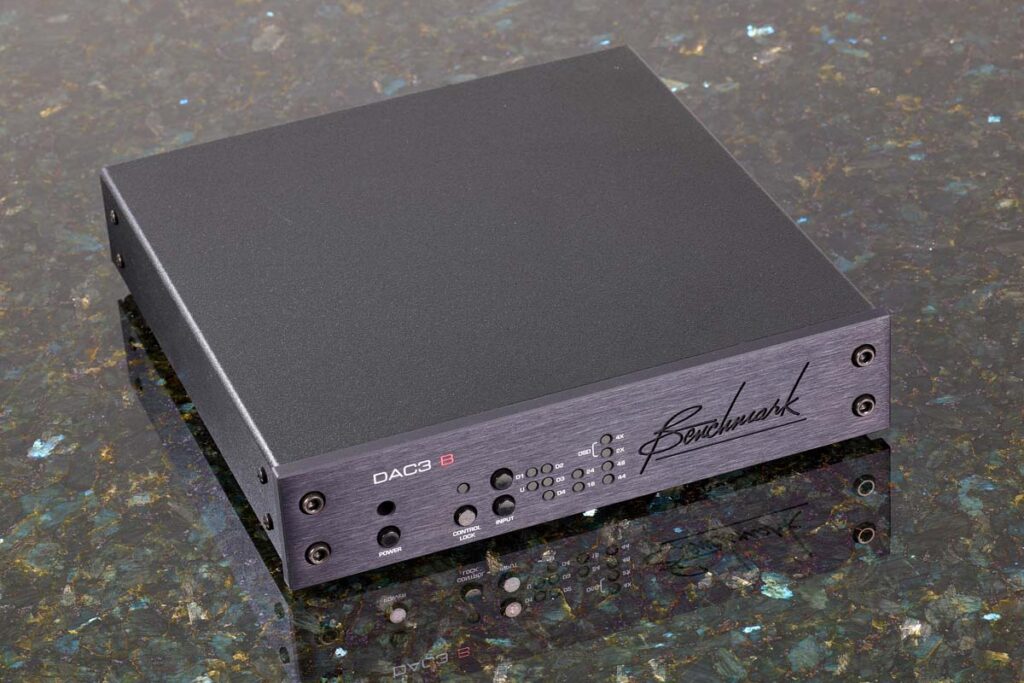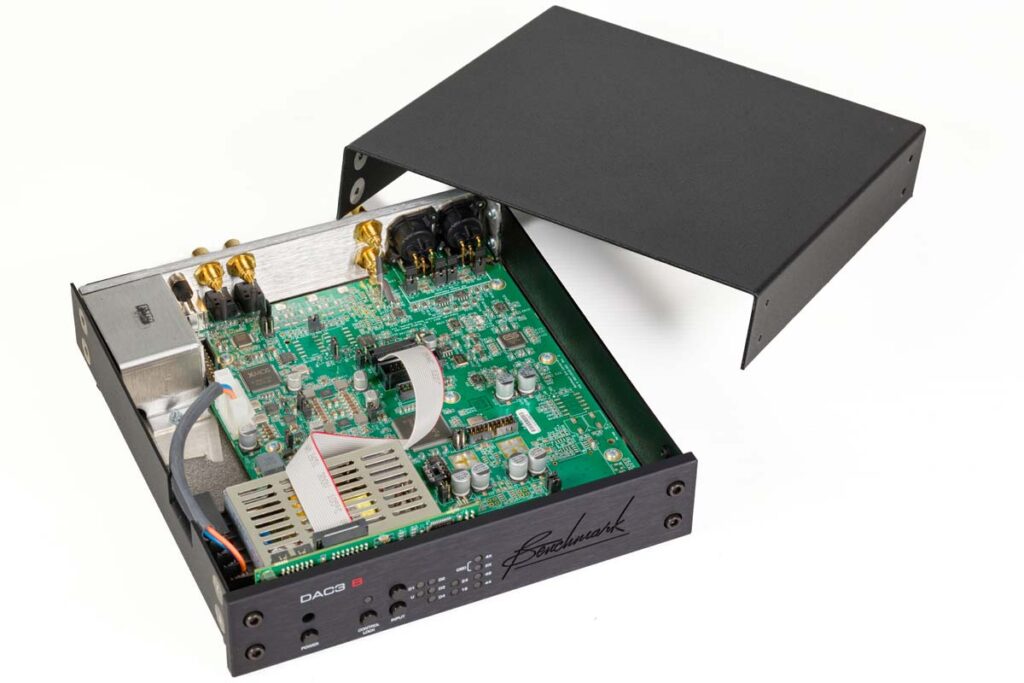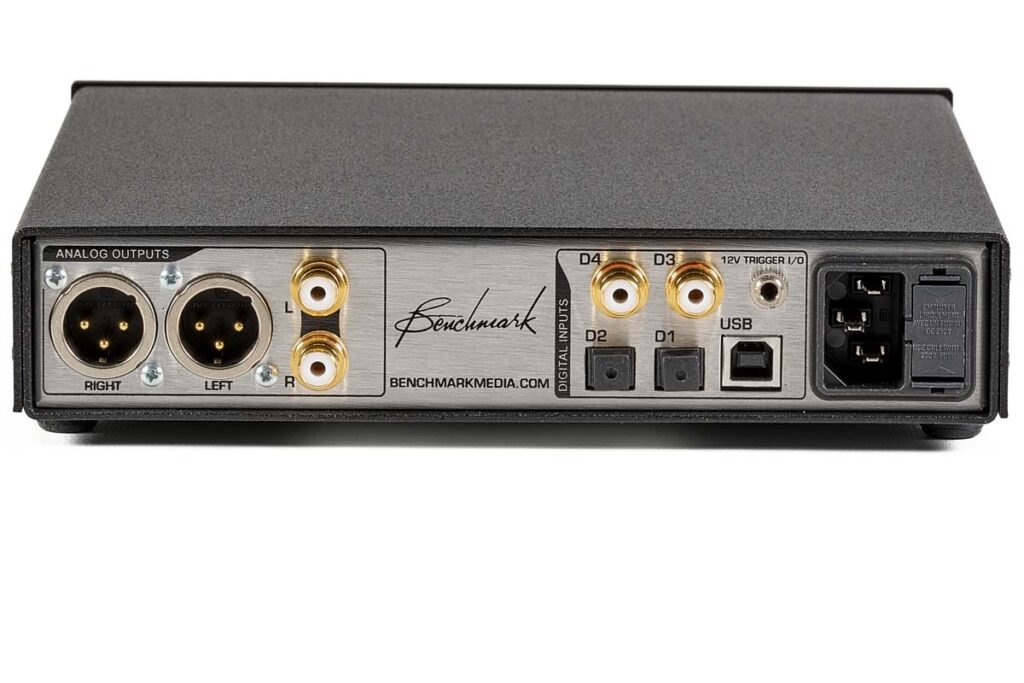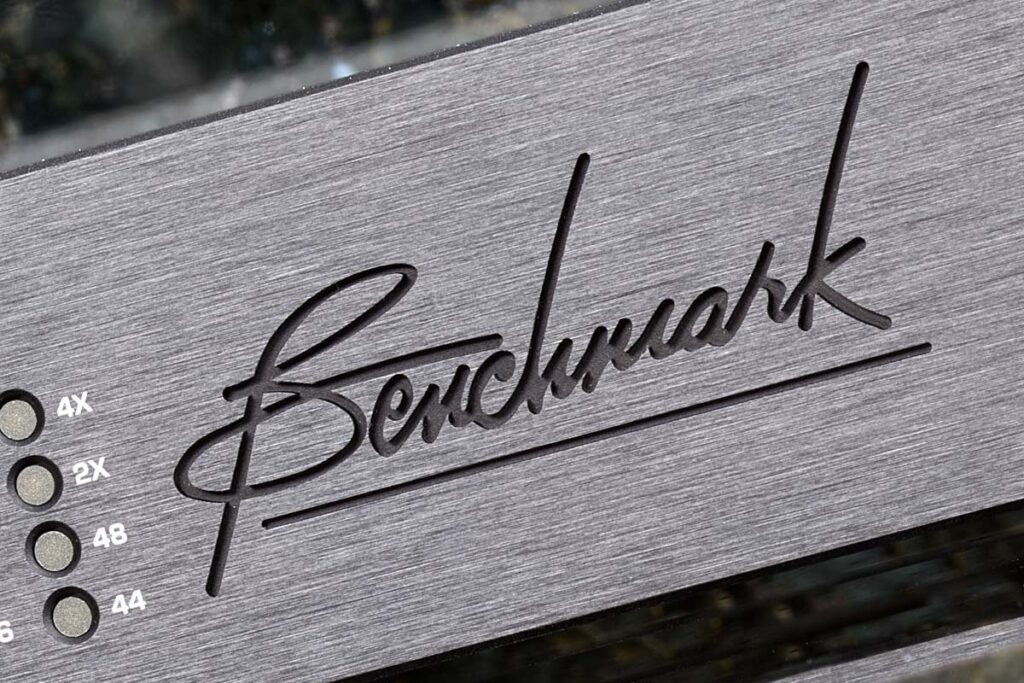The revised DAC3 B from Benchmark Audio is a D/A converter with an integrated headphone amplifier that won’t lead you up the garden path.
No nonsense – that’s a formula that will always get my attention, both technically and visually. Simple and haptically convincing casework, no “sounding” and technical reliability free from hum and noise – that’s all it takes to make me happy. It is not uncommon for companies that have at least one foot in the studio business to pique my interest. One such example are Benchmark from Syracuse in the US state of New York, who gained fame through their collaboration with THX. I also like their sustainable product policy, which only launches new devices when technological innovations warrant them rather than when the laws of the market call for an MK II series. The German distributor for Benchmark, Axmann Audio, sent me a complete setup consisting of the HPA4 headphone and line preamplifier, two AHB2 power amplifiers and the revised Benchmark DAC3 B D/A converter, all delivered in packaging barely larger than a shoe box. Even though this review is exclusively about the new DAC3, we shall mention the excellent amplifier combination for the sake of completeness.
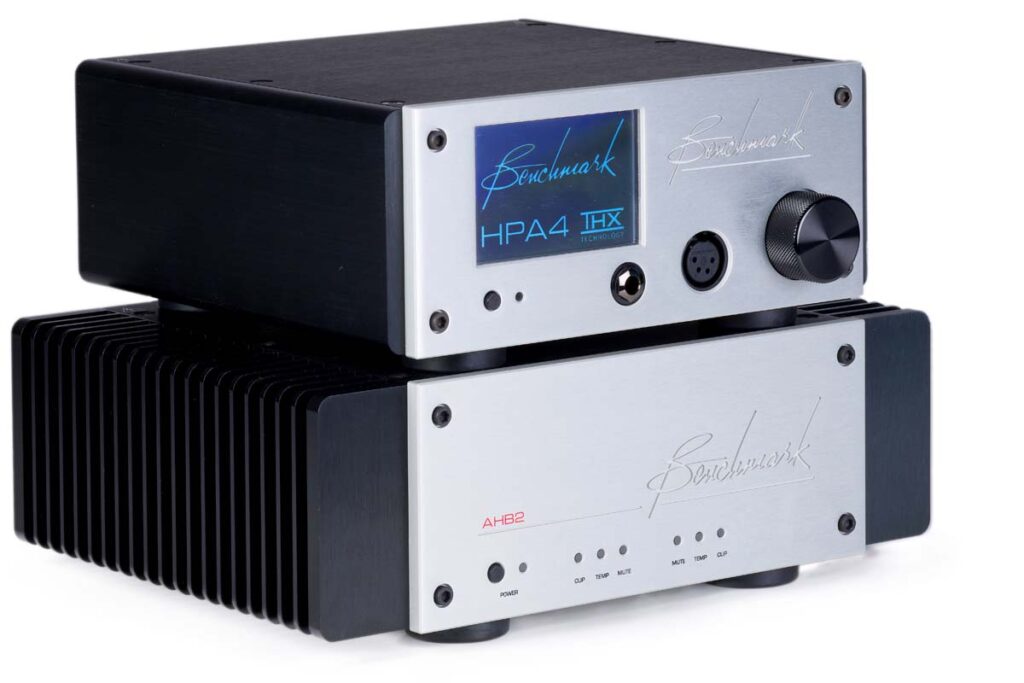
Let’s first take a look at the AHB2 power amplifier, which doesn’t necessarily have to be operated in a dual mono setup, as it already offers amazing reserves when used as a stereo power amplifier. Still, it is compact and passively cooled. These characteristics might lead you to believe that the amplifier is running in Class D mode. But this is deceptive: the AHB2 is a linear “Class H” power amplifier with bipolar output transistors and a patented feed forward concept to avoid crossover distortion. Benchmark Chief Designer John Siau comments on the development history: “The feed forward error correction system developed in conjunction with THX is much faster than conventional feedback systems. Feedback loops correct errors after they occur. In contrast, our concept avoids errors before they reach the output.”
If you look at the official measurements – 100 watts of power into 8 ohms, 190 watts into 4 ohms, only 0.0003% distortion at full rated power, plus a signal-to-noise ratio of 132 decibels – nothing should go wrong musically, provided the preamp is up to snuff. Michael Axmann from the German sales department points out that the HPA4 preamplifier is precisely matched to the power amplifier: it is possibly the only preamplifier that exceeds the signal-to-noise ratio of the ultra-quiet AHB2. Since the output level control of the HPA4 is adjustable, you can drive the power amplifier with a high amplitude signal, which in turn reduces the load on the power amplifier.
In a first listening session, I only try out the amplifier section without the DAC3 B and initially opt for the bridged mono mode with two power amplifiers as recommended by Axmann. First, I turn to John Zorn’s extensive CD box set, which was released for the 30th anniversary of Masada, the quirky combo that plowed through the New York underground in the 1990s with its inimitable mixture of free jazz and klezmer with its “Radical Jewish Culture”. Agile and nimble, the benchmark combination immaculately follows even the wildest musical swings in the comic strip-style music. The instrumental capers speak for themselves and need no additional flavor. The preamp and power amplifier prove to be congenial servants of the music. They convey the music incorruptibly and without any sort of tinge: agonizing sounds agonizing, palatable sounds palatable and fast driving syncopations are never slowed down, and all of this happens with an inimitable flow. But do you really need two power amplifiers in bridged mono mode? Let me answer that with a resounding yes and no. Do you have fairly low-efficiency loudspeakers? Do you listen to Liszt and Rachmaninov rather than Bach and Mozart or Massive Attack rather than Muddy Waters? Do you often listen to music at low levels late at night? Then you may want to consider two power amplifiers. Two of the power amplifiers grip the bass range with an iron fist, which makes low piano or synth chords stand out even more firmly in the room. Dual mono mode also offers more of the supporting power that guarantees a high-end performance even at low listening levels.
My advice: Simply borrow two power amplifiers from your trusted dealer and take your time to try out what suits your needs. And when you then want to squeeze the best out of them, try the silver cables from Axmann Audio instead of the already formidable in-house cables from Benchmark. The difference isn’t huge, but the crisp highs and the completely detached flow are the icing on the cake.
Let’s now complete our benchmark chain and add the DAC3 B, which proves to be an uncomplicated companion in terms of connectivity. Both my Mac Mini and my Lenovo T 14s immediately recognize the converter as an output device via USB. Genuine plug’n’play without any fiddly software installation – that’s how it should be! Let’s first take a look at the solution for jitter, the digital bottleneck so to speak, where Benchmark takes a critical view of the common two-stage PLL circuits for jitter elimination. According to Benchmark, many two-stage PLLs do not eliminate enough of the low-frequency jitter. Also, two-stage PLL circuits often require several seconds to lock onto an incoming signal, which the manufacturer gives as its reason for a completely different and individual approach. They rely on the patented technology of UltraLock converters, which are said to exceed the jitter attenuation performance of two-stage PLL converters while achieving a near-instant latch-on time. Benchmark believes that UltraLock converters have an extremely high immunity to interface jitter, making the DAC3 absolutely immune to jitter artifacts.
Regardless of which part of the inner workings of a DAC you want to attribute the main responsibility for the sonic result, whether it’s the chipset, the jitter technology, the power supply or the filter signatures – the decisive factor is ultimately the interaction of the individual sections, the coherence of the tuning, which leaves us musically satisfied. And I have to confess that the DAC3 didn’t simply leave me perfectly happy – on several occasions, it was responsible for my jaw dropping in amazement. Let me use a recording to explain this in a little more detail. Parallel to my work with the DAC3, I wrote an obituary for the pianist Maurizio Pollini for FIDELITY No. 74. I listened to a number of recordings, including the CD reissue of the legendary Chopin Etudes from 1972, released in the digital series “The Originals”. The circling chromatic finger exercises in the right hand in the A minor Etude (op. 10 no. 2), this musical perpetuum mobile seems to float in Pollini’s playing. Chopin leaves the structuring of the piece to ascending staccato chords, which Pollini, unlike many others, does not artificially emphasize, as it leads to a strange imbalance in this etude for many pianists. Rather, he allows them to run along almost imperceptibly. The difficulty with playback is that the equipment has to maintain this balance between the right and left hand. If I play the CD on my Naim CD5, the bass sounds a little padded, the structuring effect that Pollini achieves here despite his soft touch in the staccato doesn’t really become apparent. If I play the 16/44 rip of the recording made especially for this review on my somewhat older Grace 903, the slightly muffled presentation changes only slightly, even though the Grace 903 comes from the studio range. However, when I listen to Pollini’s interpretation of the Etude via the DAC3, something incredible happens: not only do the chromatic sixteenth-note runs sound even more iridescent – the slight padding in the mid-range and upper bass is suddenly gone, making it audible how Pollini keeps the piece in balance. Only when played back with the DAC3 does the full genius of Pollini become apparent. This is actually a strength of the complete benchmark chain: it not only allows me to look into the recording structure, but in the best case it also reveals the artistic intention.
If you purchase the benchmark combination in the full configuration and, if necessary, with two power amplifiers, then you can be sure that you will probably have everything you need in terms of neutrality, transparency and dynamics. And if you also own loudspeakers that are as neutral as possible – in my case it was a pair of Lyngdorf Cue-100s during the test phase – then you can rest assured that no one will be able to fool you when it comes to recording quality – you’ll definitely be on the untouchible side.
Accompanying Equipment
Turntables: Thorens TD 126 MK III, Technics SL-1210 MK2 | Tonearm: Koshin GST 801 | Cartridges: Sumiko Blackbird, Ortofon Concord Century | Phono preamplifier: Innovative Audio Ultimate 2b, Thel Phono M | CD player: Naim CD5i | Streamer: Naim CD5 XS | Integrated amplifier: Naim SuperNait | Speakers: Gamut Phi 7, Lyngdorf Cue-100 | Headphones: Beyerdynamic DT 1770 Pro | Accessories: Wireworld, Sommer, Creaktiv
DAC Benchmark DAC3 B
Concept: 2-channel D/A converter with integrated headphone amplifier | DAC chipset: ES9028PRO (24 bit/192 kHz); direct DSD conversion | Special features: isolated inputs thanks to UltraLock3 jitter system; remote-controllable; also available as DAC3 L (pure DAC, with volume control) or DAC3 HCG (like L, with headphone amplifier) | Inputs: 2 x S/PDIF (coaxial), 2 x S/PDIF (optical), USB | Outputs: 2 x line (XLR/cinch), 3.5 mm mini-jack (headphones, variable output) | Dimensions (W/H/D): 21/5/22 cm | Weight: 1.36 kg | Warranty period: 2 years (max. 5 years with registration) | Price: around € 2390
Axmann Audio
Dr. Michael Axmann
Karl-Giesen-Straße 19
51467 Bergisch Gladbach
Phone +49 2202 863271
info@silberkabel.de


